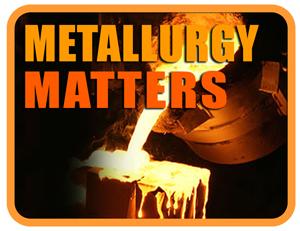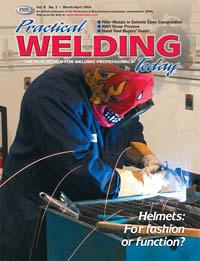Contributing Writer
- FMA
- The Fabricator
- FABTECH
- Canadian Metalworking
Categories
- Additive Manufacturing
- Aluminum Welding
- Arc Welding
- Assembly and Joining
- Automation and Robotics
- Bending and Forming
- Consumables
- Cutting and Weld Prep
- Electric Vehicles
- En Español
- Finishing
- Hydroforming
- Laser Cutting
- Laser Welding
- Machining
- Manufacturing Software
- Materials Handling
- Metals/Materials
- Oxyfuel Cutting
- Plasma Cutting
- Power Tools
- Punching and Other Holemaking
- Roll Forming
- Safety
- Sawing
- Shearing
- Shop Management
- Testing and Measuring
- Tube and Pipe Fabrication
- Tube and Pipe Production
- Waterjet Cutting
Industry Directory
Webcasts
Podcasts
FAB 40
Advertise
Subscribe
Account Login
Search
Metallurgy Matters: Solidification—It’s more than meets the eye
- By Bob Capudean
- March 16, 2015
- Article
- Metals/Materials
There’s a lot going on as your weld puddle solidifies. Grains are trying to grow in a variety of directions, and the entire process can get quite competitive, because some grains grow faster and block the growth of others.
Which grains grow faster depends on their orientation at the point where liquid weld metal meets the solid metal of the base metal. Along this interface, portions of the base metal grains are unmelted. These solid portions act as nucleation sites where the weld metal can solidify. This means each of the base metal’s solid portion grains provides a nucleus for atoms still in a liquid state. These atoms begin to form crystal sites, and these crystals continue growing into grains while maintaining the same crystal orientation.
But metal crystals find it easier to grow in certain crystallographic directions. This means some grains are in a better position—they’re more favorably oriented—and tend to grow longer and farther than others. At the same time they tend to block the growth of grains that weren’t so lucky.
As the grains continue to grow, the amount of liquid decreases until the weld joint is completely solid. These growth patterns produce relatively long grains that grow parallel to heat flow and give the solid weld metal’s macrostructure a columnar look.
Dendritic Growth
In our last column we mentioned that, depending on composition and cooling rate, a weld metal solidifies either in cellular or dendritic growth mode. But most commercial metals experience microsegregation of alloying (solute) and residual elements as the weld metal solidifies. And because this microsegregation is associated with, and primarily responsible for, the formation of dendrites—crystal growths that resemble pine trees—most of the metals we deal with solidify in dendritic growth mode.
Consequently, dendrites are important. They’re also complicated. As the primary dendrites grow into the liquid, these solid areas reject alloying elements that are more soluble in the liquid metal. These rejected solutes diffuse into the remaining liquid. That, in turn, lowers the freezing point.
Keep in mind that grains are growing and the liquid area is getting smaller. As it does, these rejected solutes concentrate near the liquid-solid interface, interrupting crystal growth. Not to be outdone, the blocked grains simply “grow arms,” and this lateral growth produces the dendrite arms typical of as-solidified metals.
Furthermore, a number of dendrites can grow simultaneously from the same grain, and each will have the same crystal orientation.
All of this can and often does result in a final structure with dendrites existing in a solute-rich environment, which causes the weld metal’s structure to look coarse under low magnification. That’s because you see only the grain structure. But if you increase the magnification, you’ll see the fine dendritic structure, with the spacing between each arm indicating not only alloy segregation, but also the rate of solidification. The closer the dendrite arms, the faster the metal solidified.
Heat Input
So far we’ve talked a lot about solidification rates, but what about heat input? Doesn’t the amount of heat put into the weld influence the dendrite arm spacing? Indirectly, yes. Dendrite arm spacing is an exclusive function of solidification rate, but heat input controls how fast the metal solidifies, with the solidification time proportional to heat input (we’ll skip the math that shows this).
Heat input also has a direct effect on the weld metal’s grain size: More heat means larger grain, although there isn’t a fixed relationship. Plus, things like vibration, nucleating agents, and other process variables influence grain size.
So more heat means larger grains and greater spacing between dendrite arms (because it takes longer for the weld metal to cool). This is generally just the opposite of what we want. Why? Because weld metals with fine microstructures offer better mechanical properties than those with coarse microstructures.
The Value
So what’s it all mean? Fortunately, solidification mechanics is more than just an exercise. This information can help solve problems related to the solidification process.
For example, we know that lower-solidus impurities are concentrated in the areas last to freeze—the areas between the dendrite arms. Solidus is the highest temperature at which a metal or its alloy is completely solid, basically, the melting point.
Now consider what we know about heat input. The more heat you put in, the slower the cooling rate. Slower cooling gives those lower-melting-point impurities more time to segregate into the areas that are last to solidify: the areas between the dendrite arms. We also know that slower cooling causes a coarser dendritic structure with greater space between the arms.
More space, combined with more time for impurities to segregate into that space, leads to a greater concentration of lower-melting-point elements between the dendrite arms. And that leads to interdendritic cracking. Plus, high concentrations of impurity elements can affect the mechanical properties of the solid metal.
Granted, you’re not going to identify interdendritic cracking as the culprit when you look at a failed weld with the naked eye. But at least you now understand another reason for avoiding excessive heat input—although heat inputs that are too low can cause problems too. We’ll address that another time.
It’s often necessary to analyze welding problems from the standpoint of solidification. And while dendritic growth mode is considered the norm in most commercially available alloys, it can be altered. Variables like cooling rate, direction of heat flow, alloying in the weld metal, and even the nature of the nucleating crystals available to the liquid weld metal can all influence dendrite growth and, in some cases, even circumvent it.
Clear as mud, right? Fortunately, this should be enough about dendritic growth modes, nucleating sites, and the rest—at least for now. Next time we’ll begin looking at the different reactions that take place during welding, beginning with gas-metal reactions and their influence on both ferrous and nonferrous welds.
About the Author

Bob Capudean
Back Alley Customs
About the Publication
subscribe now

The Welder, formerly known as Practical Welding Today, is a showcase of the real people who make the products we use and work with every day. This magazine has served the welding community in North America well for more than 20 years.
start your free subscription- Stay connected from anywhere

Easily access valuable industry resources now with full access to the digital edition of The Fabricator.

Easily access valuable industry resources now with full access to the digital edition of The Welder.

Easily access valuable industry resources now with full access to the digital edition of The Tube and Pipe Journal.
- Podcasting
- Podcast:
- The Fabricator Podcast
- Published:
- 04/16/2024
- Running Time:
- 63:29
In this episode of The Fabricator Podcast, Caleb Chamberlain, co-founder and CEO of OSH Cut, discusses his company’s...
- Industry Events
16th Annual Safety Conference
- April 30 - May 1, 2024
- Elgin,
Pipe and Tube Conference
- May 21 - 22, 2024
- Omaha, NE
World-Class Roll Forming Workshop
- June 5 - 6, 2024
- Louisville, KY
Advanced Laser Application Workshop
- June 25 - 27, 2024
- Novi, MI
































